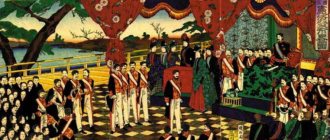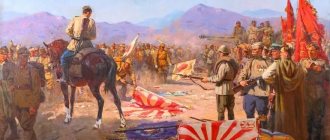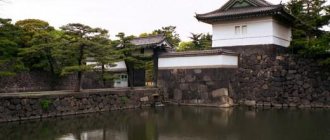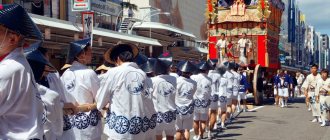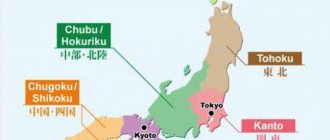The beginning of a new era
Japan began to change in the early 19th century under the gradually increasing influence of Western powers. At the beginning of the 17th century, the government decided to limit international contacts and ban Christianity in order to preserve the internal integrity and culture of the country. These prohibitions remained in place in the first half of the 19th century, but the situation on the world stage was changing, and Japan had to adapt to new realities.
In the Land of the Rising Sun, at the beginning of the 19th century, economic growth was noted due to the development of manufactories. In the first years of the century, 90 manufactories operated, by the middle of the third decade there were almost 400. Development affected all areas of industry, the production of copper, iron, and gold mining. The period was accompanied by the formation of a progressive layer of the industrial bourgeoisie. The transition from a feudal social system to a bourgeois one was prepared by the cultural policy of recent centuries - by the beginning of the century, the level of education among the population was one of the highest in the world.
The Japanese attitude towards education is a special issue. In Japan there were samurai public and schools for the common population. Listeners were taught to write, read, count; explained the principles of Confucianism. The state encouraged a progressive educational system; Japanese studies and Dutch studies were taught in many institutions. An important element of the educational policy of the era is kokugaku, a principle laid down by Motoori Norinaga, and focused on studying the history of his native country and the development of Japanese individuality.
Country of educated people
Administrative and government reforms
Based on the administrative reform of 1871, 50 large prefectures were created in Japan, headed by managers - prefects. Prefects served as governors and were strictly responsible for their actions to the government.
Thanks to this division, the government achieved its goal - the overthrow of feudalism. Political fragmentation was eliminated, large princely landownership was abolished, and the difference between classes was minimized.
The government has also experienced some changes. According to the constitution, legislative power belonged to parliament, which consisted of two chambers.
The established high social and property qualifications excluded most of the population from elections.
End of the century
The history of the Land of the Rising Sun in the second half of the 19th century combines traditionalism and innovation, industrial breakthroughs and dramatic social changes. They began in 1853, the year when the American president sent 4 warships to the eastern islands, demanding the establishment of international relations. American technology, new weapons, and powerful steamships delighted, impressed, and frightened the inhabitants of the archipelago so much that the Tokugawa shogunate made a historic decision to resume relations with Western countries. A year later, we signed an agreement, defining regulations for interaction between countries, and began the construction of 2 ports focused on international trade relations.
Gradually, in the second half of the century, Japan signed trade agreements with other major powers: Russia, Great Britain, and the modern Netherlands. Although the authorities faced strong opposition and were ostracized for their unconventional decisions, in the long term, opening the borders turned out to be a timely and effective decision. However, foreign policy is only part of the history of the Land of the Rising Sun in the 19th century. Conflict grew within the state, social tension increased.
An important page in the country's history opened in 1868 with the overthrow of the Tokugawa clan. The revolutionaries handed over the reins of power to Emperor Mutsuhito; the new government began a series of reforms. The authorities took into account the trends of the times: interest in Western countries, the desire to put new products into practice, a passion for learning about a different life. Most of the innovations were aimed at the bourgeoisie, the landowners, in order to make the country independent and put it on the capitalist path.
Japan greeted the end of the 19th century as a developed industrial power with a strong cultural potential and a high level of education. It became the first of its kind in the world, harmoniously combining the specifics of Western development and traditional Eastern values. On the wave of success, the country began hostilities, starting a war with China, then Russia.
Unity of East and West
Meiji reforms
Administrative reform
The condition for the formation of unitary Japan was the elimination of the old federalist structure of the country. Its units were autonomous khans ruled by daimyos. During the civil war of 1868-1869, the Japanese government confiscated the possessions of the shogunate, which it divided into prefectures. However, the territories of the khans remained outside his direct control. On January 20, 1869, the daimyos of four pro-government hans: Satsuma, Choshu, Tosa and Hizen submitted an appeal stating that everything in Japan belonged to the Emperor. In February 1869, officials Kido Takayoshi and Okubo Toshimichi proposed that the Emperor reassign these territories to the new government. The proposal was immediately agreed to by daimyo supporters from Satsuma, Choshu, Tosa and Hizen, who returned their lands to the monarch along with the population. On July 25, 1868, the government ordered the daimyo of other khans to do the same, which was carried out without resistance; only twelve princes did not voluntarily transfer the registers of lands and people, but were forced to do so according to the order.
In exchange for land, daimyos became heads of regional offices of the central government and received government salaries. Although the lands of the khans formally passed to the state, the khans themselves were not abolished. Their daimyo retained the right to collect taxes and raise troops on the lands entrusted to them, and thus remained semi-autonomous. Due to such a half-hearted policy of the central government, discontent grew in the regions. In order to finally move to a unitary form of government, on August 29, 1871, the Imperial Government proclaimed the elimination of khans throughout Japan and the establishment of prefectures in their place. Former daimyo khans were relocated from the regions to Tokyo, and in their place were appointed prefectural governors dependent on the center. Until 1888, the number of prefectures was reduced from 306 to 47, Hokkaido was allocated as a special district, and three large cities - Tokyo, Kyoto and Osaka - were equated to prefectures.
Government reform
Simultaneously with the administrative reform, changes were taking place in the structure of the government. The structure of the Japanese government of the 8th century was taken as the basis for the new executive vertical. Since August 15, 1869, the government has been divided into three chambers: main, left and right. The Main Chamber performed the functions of the cabinet of ministers. It consisted of a great minister of state, left and right ministers, and advisers. The left chamber was the legislative body and an advisory body to the main chamber.
The right chamber included eight ministries, which were led by ministers and their deputies. Most of the positions in the government were occupied by people from the former khans of Satsuma (Saigo, Okubo Toshimichi, Kuroda Kiyotaka), Choshu (Kido Takayoshi, Ito Hirobumi, Inoue Kaoru, Yamagata Aritomo), Tosa (Itagaki Taisuke, Goto Shojiro, Sasaki Takayuki) and Hizen (Okuma Shigenobu, Oki Takata, Soejima Taneomi, Eto Shimpo), who formed the so-called han factions in it. The main positions were occupied by the capital's aristocrats, such as Sanjo Sanetomi and Iwakura Tomomi.
Military reform
One of the main tasks of the Imperial government was to create a new combat-ready army. After the liquidation of the khans, their troops, consisting of samurai, were reassigned to the Ministry of War. On January 10, 1873, on the initiative of Omura Masujiro and Yamagata Aritomo, the government introduced universal conscription in the country. From now on, all men who had reached the age of 20 were required to serve in the army, regardless of their social origin. Heads of families and their heirs, officials, students, as well as persons who paid a ransom of 270 yen were exempt from military service. The newest Imperial Army began to be formed primarily from peasants.
Simultaneously with the military reform, police units separate from the army were created. Until 1872 they were subordinate to the Ministry of Justice, and from the next year - to the Ministry of Internal Affairs. The Metropolitan Police was organized into a separate Tokyo Police Department.
Social reforms
To build the Japanese national state, the Imperial Government also pursued an active social policy. On June 25, 1869, it formed two privileged classes - the titled (kazoku) and untitled (shizoku) nobility. The first included the capital's aristocrats themselves and the daimyo of the liquidated khans, and the second included the middle and small samurai. Thanks to the formation of two classes, the government tried to overcome the eternal confrontation between samurai and aristocrats, as well as eliminate social differentiation and the medieval model of “master-servant” relations in the samurai environment. Along with this, the Imperial government proclaimed the equality of peasants, artisans and merchants, regardless of occupation and position. They began to be called “common people” (heimin).
In 1871, the government equated it with pariahs who had been discriminated against during the Edo period. The common people were obliged to have surnames that had previously been borne exclusively by samurai, and titled and untitled nobility were now allowed inter-class marriages. Traditional restrictions on travel and career changes have been lifted. On April 4, 1871, the Imperial government issued a law on population registration. The following year, the population was entered into the family register books in accordance with three class categories - titled and untitled nobility, and common people.
The Japanese nobility was completely supported by the state. They received an annual pension, which amounted to 30% of the country's entire budget. In order to ease the state burden, in 1873 the government issued the Law on the Return of Pensions to the Emperor, which obliged the nobility to give up pensions in exchange for the payment of one-time bonuses. However, the problem was not solved, and the state debt for pension payments was constantly growing, so in 1876 the authorities finally abolished the practice of assigning and paying them. In this regard, the legal difference between the samurai, who were banned from carrying katanas from the same year, and the common people disappeared.
To ensure their existence, part of the privileged class became government employees: government clerks, police officers and teachers. Many began to engage in agriculture. However, most of them went into commerce and quickly went bankrupt due to lack of entrepreneurial skills. To save the samurai, the government provided subsidies and encouraged them to explore semi-wild Hokkaido. However, these measures turned out to be insufficient, which became the cause of future unrest.
Land tax reform
The main task of the Imperial Government in building a modern Japan was to create a reliable financial system. The main source of replenishment of the state treasury was the land tax in the form of rent in kind, which Japanese peasants had been paying to their masters for centuries. After the khans were liquidated, the government took over their debt rights and obligations, so it was extremely difficult to replenish the budget with money. Therefore, the authorities undertook to carry out land and tax reforms in order to stabilize Japanese finances.
In 1871, the Imperial government allowed the creation of new arable plots on untouched lands, and in the following 1872 the ban on the sale of land was lifted and the existence of private property was recognized. Property owners received land ownership certificates, which indicated the price of the plot. The certificate system eliminated the traditional communal form of land tenure. On July 28, 1873, on the basis of this system, the Imperial Government began land tax reform, which was completed in 1880.
As a result of the reform, instead of an unstable harvest, the criterion for taxation became a stable price for land, and land owners turned into taxpayers. Land tax had to be paid in cash in the amount of 3% of the value of the land. Mountain forests and areas that were used jointly by community members were designated as no-man's lands. These transformations ensured stable filling of the state treasury and contributed to the development of commodity-money relations in the regions. However, on the other hand, they caused new social differentiation and increased the tax burden in the countryside and, as a result, became the cause of peasant unrest.
Results for Japan
The 19th century gave the Land of the Rising Sun:
- strong industry;
- capitalist direction of further development;
- social change;
- new government;
- strengthening the already powerful institution of education;
- new opportunities for citizens regardless of social class;
- international relationships;
- rapid economic growth.
Exception country
Centralization of power
In 1871, the new government of Emperor Meiji, to prevent the collapse of his nascent power, abolished the system of han principalities and replaced them with prefectures subordinate to the center. Before this, each of the approximately 270 principalities had its own armed forces and exercised political will within a decentralized power structure. The sudden abolition of this structure was practically a coup d'etat. The Meiji leaders decided that their government should be the sole political authority in the country so that it could fulfill the urgent task of building a modern state.
Reforms in Japan in the 19th century
To gain independence, stabilize the economy, and develop capitalism in the 19th century in the Land of the Rising Sun:
- formed a regular army;
- replaced principalities with prefectures subject to centralized authority;
- abandoned the untouchable caste;
- gave samurai the right to choose a profession;
- introduced the yen;
- defined free trade;
- moved the capital to Tokyo;
- opened the University of Tokyo;
- abandoned princely, samurai property;
- land transactions were allowed;
- paid for the construction of industrial enterprises from government funds;
- adopted the Constitution.
Agrarian and land tax reforms
The agrarian reform of 1872-1873, which consolidated land relations, led to the eradication of feudal rights to land. Land became capitalist property, subject to a single land tax.
Since 1871, the purchase and sale of land has been allowed at the state level.
It was during the Meiji period that peasants began to pay taxes not in rice, but in money.
There was an increase in urbanization and manufacturing production.
Japanese schools underwent changes in the education system, opening up the possibility of studying the achievements of foreign science.
The Meiji Reform Period is the era that gave us modern free Japan with its advanced technology. After all, we all know the brands Toyota, Mitsubishi, etc. originate precisely then, and the liberation of the country from the yoke of the West, to some extent, helped other Asian countries achieve independence!
With this, I hasten to say goodbye to you, subscribe to my blog updates and recommend it to your friends. See you later!
By the way, I now have a channel on Telegram! Now you can be the first to know interesting and useful things. Join us on Telegram: @japantouch!
Lika Raido
